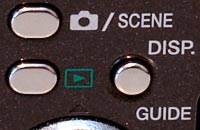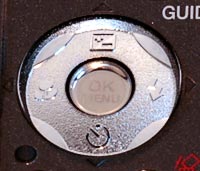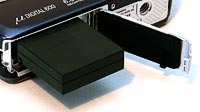Olympus Mju Digital 600
(Olympus Stylus 600 in the USA)
Review Date: October 27th 2005
|
Ease of Use
The Olympus Mju Digital 600 is a stylish and eye-catching camera. The plastic, splash-proof body is compact and you won't really notice the camera if you carry it in a trouser pocket. Due to the body being made from plastic, the Olympus Mju Digital 600 is a pretty light camera around at 130g without the battery fitted. The rear is dominated by the large 2.5 inch LCD screen, and on the front is a snazzy sliding lens cover that retracts and allows the lens to extend when the camera is turned on. If the appearance of your digital camera is important to you, then you won't be disappointed with the Olympus Mju Digital 600. I did find that the large LCD screen is susceptible to fingerprints and scratches, so it's probably best to buy a suitable case to protect it.
The Olympus Mju Digital 600 is quite comfortable to hold, although your right thumb naturally rests on several buttons on the rear of the camera - there is no empty space for it. Thankfully the buttons requite a positive push to activate them, so you can't accidentally set the wrong mode. Olympus have chosen to use Zoom buttons on this camera which have a space between them, rather than an all-in-one zoom lever. The space is large enough to make it impossible to operate the zoom without actually moving your thumb from one button to the other, which I found a little awkward and slow to use. Another design element that I disliked was the arrow pad, which feels very spongy and unresponsive. A nice touch is the ability to turn the camera on via the Play button as well as via the Power button, giving quick access to showing off your photos.
| Camera/Scene Mode / Play / Disp / Guide Buttons | Zoom/Magnify Buttons |
 |
 |
You directly access the various flash, exposure compensation, timer and macro options by clicking the four arrows on the arrow pad. It's good to see commonly used features accessed by external buttons, which speeds up the operation of the camera. The only notable exception is ISO speed which is in the menu system. I would have preferred to see a dedicated button for this option. All 11 external controls are clearly labeled using industry-standard symbols and terminology. Olympus have included the Guide feature that is also on their other newer cameras. This is basically 15 handy tips for common photographic situations, a useful feature for beginners. It is opened in a rather unintuitive way though - you have to press the Exposure Compensation arrow first and then press the Disp / Guide button. Overall the camera body feels well-designed and not too cluttered, despite the presence of that large LCD screen. Obviously this is helped by the omission of an optical viewfinder, something which you should take into consideration if you are interested in the Olympus Mju Digital 600. Also note that the plastic tripod socket is positioned in the extreme right corner of the bottom of the camera, out of line with the lens - not the best position.
If you have never used a digital camera before, or you're upgrading from a more basic model, reading the comprehensive and easy-to-follow manual before you start is a good idea, although unfortunately Olympus have chosen to cut costs and only provide it as a PDF on a CD. For more experienced users, a quick look through the PDF manual for the few functions that are not so self-explanatory (like the Image Blur function) is all that's needed.
| Arrow Pad / Exposure Compensation / Flash / Timer / Macro / OK/Menu Buttons | On/Off / Shutter Buttons |
 |
|
The menu system on the Olympus Mju Digital 600 is very similar to all the other Olympus cameras that I have reviewed, so you will feel right at home if you have used an Olympus digicam before. Pressing the OK/Menu button in the middle of the arrow pad accesses the main menu options. These include setting the image quality, white balance, ISO and a sub-menu called the Mode Menu, which has 3 sub-menus that contain settings like the metering mode and formatting the memory card. Due to the large and bright LCD screen, the various options are easy to access and use, especially as only 5 are shown onscreen at one time. There are a couple of features buried in the menu system that I would have liked to be accessible via an external button, namely ISO speed and Drive (continuous shooting options), but overall Olympus have struck the right balance.
There are a couple of innovative features on the Olympus Mju Digital 600 that aim to make life easier for you. The camera has an Image Blur Reduction feature, which is found in the Scene menu (number 24). Note that this isn't an image stabilizer function. Instead, when the option is selected, the camera chooses a very fast ISO speed in order to then set a faster shutter speed, and successfully capture the fast action or deal with low-light conditions. Unfortunately the faster ISO speeds affect the image quality so much (in a negative way - see next page) that it is hardly worth using this feature. Also, the image size is automatically reduced to 1600x1200 pixels to attempt to offset the effects of the much noisier images. Meanwhile, Brightcapture technology is a fancy way of saying that the LCD screen automatically gets brighter in low-light conditions. The LCD screen is indeed easy to read in almost completely dark conditions, but I'm not sure it warrants a completely new marketing term.
| Memory Card Slot | Battery Compartment |
 |
 |
The start-up time from turning the Olympus Mju Digital 600 on to being ready to take a photo is reasonable at around 2 seconds, although it takes another 2 seconds to zoom from the widest focal length to the longest, and back again, disappointing given that it only has 3x magnification. Focusing is quick in good light and the camera happily achieves focus indoors or in low-light situations despite the lack of a focus assist lamp. The visibility and refresh rate of the 2.5 inch LCD screen are perfectly acceptable. It takes about 1.5 seconds to store an image, allowing you to keep shooting as they are being recorded onto the memory card - there is no LCD blackout between each image. In the normal continuous shooting mode the camera takes photos at 1.3 frames per second at SHQ quality, not exactly lightning fast. This can be greatly improved by selecting the High speed mode, which allows 4.3 frames per second, but unfortunately this only works at 1600 x 1200 resolution. All in all the Olympus Mju Digital 600 is average in terms of operational speed.
Once you have captured a photo, the Olympus Mju Digital 600 has a very extensive range of options when it comes to playing, reviewing and managing your images. You can instantly scroll through the images that you have taken, view thumbnails in different sizes, zoom in and out up to 8x magnification, view slideshows, add an audio clip to each image, delete, protect, resize and rotate an image. A menu option called Red-Eye Fix promises to do exactly what it says, although I found that it didn't actually remove the limited red-eye that occurred in my flash test shots. The Album feature is a great way to show off your photos to friends and family. You can create up to 12 albums on an xD-Picture card with each one containing a maximum of 200 photos. A new Frames feature means you can get more creative by placing your photo in a clip-art like frame, and the Title option allows you to add decorative text message (Good Luck, Happy Birthday etc) to a photo. There are however only a very limited number of designs available. Perhaps of more use is the Calendar, which enables you to see which pictures you took on a particular day and even add a photo to a calendar design. The Olympus Mju Digital 600 also allows you to alter the Brightness and Saturation of a photo that you have taken. The Display button toggles basic settings information about each picture on and off, such as the white balance and ISO rating, and there is a small histogram available during both shooting and playback which is helpful in evaluating the exposure.
On the whole the Olympus Mju Digital 600 is a stylish and fairly easy to use digital camera, with excellent playback options and a few innovative features, some of which are more useful than others.
|
 PhotographyBLOG is a member of the DIWA organisation. Our test results for the Olympus Mju Digital 600 have been submitted to DIWA for comparison with test results for different samples of the same camera model supplied by other DIWA member sites.
PhotographyBLOG is a member of the DIWA organisation. Our test results for the Olympus Mju Digital 600 have been submitted to DIWA for comparison with test results for different samples of the same camera model supplied by other DIWA member sites.
